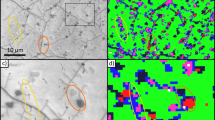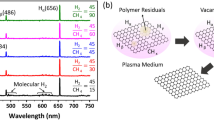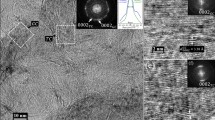Abstract
Engineering of defects located in grains or at grain boundaries is central to the development of functional materials. Although there is a surge of interest in the formation, migration and annihilation of defects during ion and plasma irradiation of bulk materials, these processes are rarely assessed in low-dimensional materials and remain mostly unexplored spectroscopically at the micrometre scale due to experimental limitations. Here, we use a hyperspectral Raman imaging scheme providing high selectivity and diffraction-limited spatial resolution to examine plasma-induced damage in a polycrystalline graphene film. Measurements conducted before and after very low-energy (11–13 eV) ion bombardment show defect generation in graphene grains following a zero-dimensional defect curve, whereas domain boundaries tend to develop as one-dimensional defects. Damage generation is slower at grain boundaries than within the grains, a behaviour ascribed to preferential self-healing. This evidence of local defect migration and structural recovery in graphene sheds light on the complexity of chemical and physical processes at the grain boundaries of two-dimensional materials.
This is a preview of subscription content, access via your institution
Access options
Access Nature and 54 other Nature Portfolio journals
Get Nature+, our best-value online-access subscription
$29.99 / 30 days
cancel any time
Subscribe to this journal
Receive 12 print issues and online access
$259.00 per year
only $21.58 per issue
Buy this article
- Purchase on Springer Link
- Instant access to full article PDF
Prices may be subject to local taxes which are calculated during checkout






Similar content being viewed by others
Data availability
The data sets generated and analysed during the current study are available from the corresponding author upon reasonable request. Source data are provided with this paper.
References
Zurutuza, A. & Marinelli, C. Challenges and opportunities in graphene commercialization. Nat. Nanotechnol. 9, 730–734 (2014).
Balasubramanian, K. et al. Reversible defect engineering in graphene grain boundaries. Nat. Commun. 10, 1090 (2019).
Yazyev, O. V. & Louie, S. G. Electronic transport in polycrystalline graphene. Nat. Mater. 9, 806–809 (2010).
Grantab, R., Shenoy, V. B. & Ruoff, R. S. Anomalous strength characteristics of tilt grain boundaries in graphene. Science 330, 946–948 (2010).
Červenka, J., Katsnelson, M. I. & Flipse, C. F. J. Room-temperature ferromagnetism in graphite driven by two-dimensional networks of point defects. Nat. Phys. 5, 840–844 (2009).
Malola, S., Häkkinen, H. & Koskinen, P. Structural, chemical, and dynamical trends in graphene grain boundaries. Phys. Rev. B 81, 165447 (2010).
Tsen, A. W., Brown, L., Havener, R. W. & Park, J. Polycrystallinity and stacking in CVD graphene. Acc. Chem. Res. 46, 2286–2296 (2013).
Tsen, A. W. et al. Tailoring electrical transport across grain boundaries in polycrystalline graphene. Science 336, 1143–1146 (2012).
Clark, K. W. et al. Spatially resolved mapping of electrical conductivity across individual domain (grain) boundaries in graphene. ACS Nano 7, 7956–7966 (2013).
Georgakilas, V. et al. Noncovalent functionalization of graphene and graphene oxide for energy materials, biosensing, catalytic, and biomedical applications. Chem. Rev. 116, 5464–5519 (2016).
Xiang, Z., Dai, Q., Chen, J. F. & Dai, L. Edge functionalization of graphene and two-dimensional covalent organic polymers for energy conversion and storage. Adv. Mater. 28, 6253–6261 (2016).
Banhart, F., Kotakoski, J. & Krasheninnikov, A. V. Structural defects in graphene. ACS Nano 5, 26–41 (2011).
Ahlberg, P. et al. Defect formation in graphene during low-energy ion bombardment. APL Mater. 4, 046104 (2016).
Vinchon, P. et al. A combination of plasma diagnostics and Raman spectroscopy to examine plasma–graphene interactions in low-pressure argon radiofrequency plasmas. J. Appl. Phys. 126, 233302 (2019).
Krasheninnikov, A. V. & Banhart, F. Engineering of nanostructured carbon materials with electron or ion beams. Nat. Mater. 6, 723–733 (2007).
Zhang, X. et al. Radiation damage in nanostructured materials. Prog. Mater. Sci. 96, 217–321 (2018).
Nordlund, K. et al. Primary radiation damage: a review of current understanding and models. J. Nucl. Mater. 512, 450–479 (2018).
Bai, X. M., Voter, A. F., Hoagland, R. G., Nastasi, M. & Uberuaga, B. P. Efficient annealing of radiation damage near grain boundaries via interstitial emission. Science 327, 1631–1634 (2010).
Kurasch, S. et al. Atom-by-atom observation of grain boundary migration in graphene. Nano Lett. 12, 3168–3173 (2012).
Kotakoski, J., Mangler, C. & Meyer, J. C. Imaging atomic-level random walk of a point defect in graphene. Nat. Commun. 5, 3991 (2014).
Beams, R., Gustavo Cançado, L. & Novotny, L. Raman characterization of defects and dopants in graphene. J. Phys. Condens. Matter 27, 083002 (2015).
Lucchese, M. M. et al. Quantifying ion-induced defects and Raman relaxation length in graphene. Carbon 48, 1592–1597 (2010).
Gustavo Cançado, L. et al. Disentangling contributions of point and line defects in the Raman spectra of graphene-related materials. 2D Mater. 4, 025039 (2017).
Ribeiro-Soares, J. et al. Structural analysis of polycrystalline graphene systems by Raman spectroscopy. Carbon 95, 646–652 (2015).
Beams, R. Tip-enhanced Raman scattering of graphene. J. Raman Spectrosc. 49, 157–167 (2018).
Gaufrès, E. et al. Hyperspectral Raman imaging using Bragg tunable filters of graphene and other low-dimensional materials. J. Raman Spectrosc. 49, 174–182 (2018).
Ferrari, A. C. & Robertson, J. Raman spectroscopy of amorphous, nanostructured, diamond-like carbon, and nanodiamond. Philos. Trans. Math. Phys. Eng. Sci. 363, 2477–2512 (2004).
Eckmann, A. et al. Probing the nature of defects in graphene by Raman spectroscopy. Nano Lett. 12, 3925–3930 (2012).
Zhou, Y.-B. et al. Ion irradiation induced structural and electrical transition in graphene. J. Chem. Phys. 133, 234703 (2010).
Das, A. et al. Monitoring dopants by Raman scattering in an electrochemically top-gated graphene transistor. Nat. Nanotechnol. 3, 210–215 (2008).
Levesque, P. L. et al. Probing charge transfer at surfaces using graphene transistors. Nano Lett. 11, 132–137 (2011).
Bruna, M. et al. Doping dependence of the Raman spectrum of defected graphene. ACS Nano 8, 7432–7441 (2014).
Bissett, M. A., Izumida, W., Saito, R. & Ago, H. Effect of domain boundaries on the Raman spectra of mechanically strained graphene. ACS Nano 6, 10229–10238 (2012).
Wang, Y. et al. Domain-boundary independency of Raman spectra for strained graphene at strong interfaces. Carbon 134, 37–42 (2018).
Ophus, C., Shekhawat, A., Rasool, H. & Zettl, A. Large-scale experimental and theoretical study of graphene grain boundary structures. Phys. Rev. B 92, 205402 (2015).
Yang, R. et al. An anisotropic etching effect in the graphene basal plane. Adv. Mater. 22, 4014–4019 (2010).
Diankov, G., Neumann, M. & Goldhaber-Gordon, D. Extreme monolayer-selectivity of hydrogen-plasma reactions with graphene. ACS Nano 7, 1324–1332 (2013).
Larionova, T. et al. Comparative characterization of graphene grown by chemical vapor deposition, transferred to nonconductive substrate, and subjected to Ar ion bombardment using X-ray photoelectron and Raman spectroscopies. Diam. Relat. Mater. 76, 14–20 (2017).
Kabir, M. & Van Vliet, K. J. Kinetics of topological Stone–Wales defect formation in single-walled carbon nanotubes. J. Phys. Chem. C 120, 1989–1993 (2016).
Chen, J. et al. Self healing of defected graphene. Appl. Phys. Lett. 102, 103107 (2013).
Huang, L. F. et al. Modulation of the thermodynamic, kinetic, and magnetic properties of the hydrogen monomer on graphene by charge doping. J. Chem. Phys. 135, 064705 (2011).
Wang, B., Puzyrev, Y. & Pantelides, S. T. Strain enhanced defect reactivity at grain boundaries in polycrystalline graphene. Carbon 49, 3983–3988 (2011).
Hashimoto, A., Suenaga, K., Gloter, A., Urita, K. & Iijima, S. Direct evidence for atomic defects in graphene layers. Nature 430, 870–873 (2004).
Zhou, L. J., Hou, Z. F., Wu, L. M. & Zhang, Y. F. First-principles studies of lithium adsorption and diffusion on graphene with grain boundaries. J. Phys. Chem. C 118, 28055–28062 (2014).
Botari, T., Paupitz, R., Alves Da Silva Autreto, P. & Galvao, D. S. Graphene healing mechanisms: a theoretical investigation. Carbon 99, 302–309 (2016).
Liu, T. H., Gajewski, G., Pao, C. W. & Chang, C. C. Structure, energy, and structural transformations of graphene grain boundaries from atomistic simulations. Carbon 49, 2306–2317 (2011).
Yu, S. U. et al. Simultaneous visualization of graphene grain boundaries and wrinkles with structural information by gold deposition. ACS Nano 8, 8662–8668 (2014).
Glad, X., Poucques, Lde & Bougdira, J. Formation mechanism of graphite hexagonal pyramids by argon plasma etching of graphite substrates. J. Phys. D 48, 495304 (2015).
Simonis, P. et al. STM study of a grain boundary in graphite. Surf. Sci. 511, 319–322 (2002).
Kotakoski, J. et al. B and N ion implantation into carbon nanotubes: insight from atomistic simulations. Phys. Rev. B 71, 205408 (2005).
Maaloul, L., Morel, S. & Stafford, L. Populations of metastable and resonant argon atoms in radio frequency magnetron plasmas used for deposition of indium-zinc-oxide films. J. Vac. Sci. Technol. A 30, 021301 (2012).
Choubak, S. et al. Graphene CVD: interplay between growth and etching on morphology and stacking by hydrogen and oxidizing impurities. J. Phys. Chem. C 118, 21532–21540 (2014).
Lin, Y.-C. et al. Graphene annealing: how clean can it be? Nano Lett. 12, 414–419 (2012).
Robert Bigras, G. et al. Probing plasma-treated graphene using hyperspectral Raman. Rev. Sci. Instrum. 91, 063903 (2020).
Acknowledgements
This work was financially supported by the National Science and Engineering Research Council (NSERC), PRIMA-Québec, Plasmionique Inc., Photon etc., the Fonds de Recherche du Québec—Nature et Technologies (FRQNT) and the Canada Research Chair programme (L.S. and R.M.). We thank C. Charpin for providing the CVD-grown graphene samples and C. Allard for technical support with RIMA measurements.
Author information
Authors and Affiliations
Contributions
P.V. performed all experimental measurements. X.G. and P.V. participated in the initial writing of the manuscript. G.R.B. developed the code used for the analysis of RIMA data. All authors were involved in the design of experiments, data interpretation and manuscript revision. L.S. and R.M. contributed to funding acquisition, project administration and supervision.
Corresponding author
Ethics declarations
Competing interests
The authors declare no competing interests.
Additional information
Publisher’s note Springer Nature remains neutral with regard to jurisdictional claims in published maps and institutional affiliations.
Supplementary information
Supplementary Information
Supplementary Discussion Sections I–VII, Figs. 1–6 and refs. 1–63.
Source data
Source Data Fig. 4
Data from Fig. 4b.
Source Data Fig. 5
Data from Fig. 5.
Rights and permissions
About this article
Cite this article
Vinchon, P., Glad, X., Robert Bigras, G. et al. Preferential self-healing at grain boundaries in plasma-treated graphene. Nat. Mater. 20, 49–54 (2021). https://doi.org/10.1038/s41563-020-0738-0
Received:
Accepted:
Published:
Issue Date:
DOI: https://doi.org/10.1038/s41563-020-0738-0
This article is cited by
-
Prolonged photostability in hexagonal boron nitride quantum emitters
Communications Materials (2023)
-
Structural characterizations and electrochemical performances of rGO-based anode materials for lithium-ion battery
Journal of Materials Science: Materials in Electronics (2023)
-
Highly Thermally Conductive Polymer/Graphene Composites with Rapid Room-Temperature Self-Healing Capacity
Nano-Micro Letters (2022)
-
Low defect and high electrical conductivity of graphene through plasma graphene healing treatment monitored with in situ optical emission spectroscopy
Scientific Reports (2021)
-
Selective nitrogen doping of graphene due to preferential healing of plasma-generated defects near grain boundaries
npj 2D Materials and Applications (2020)



